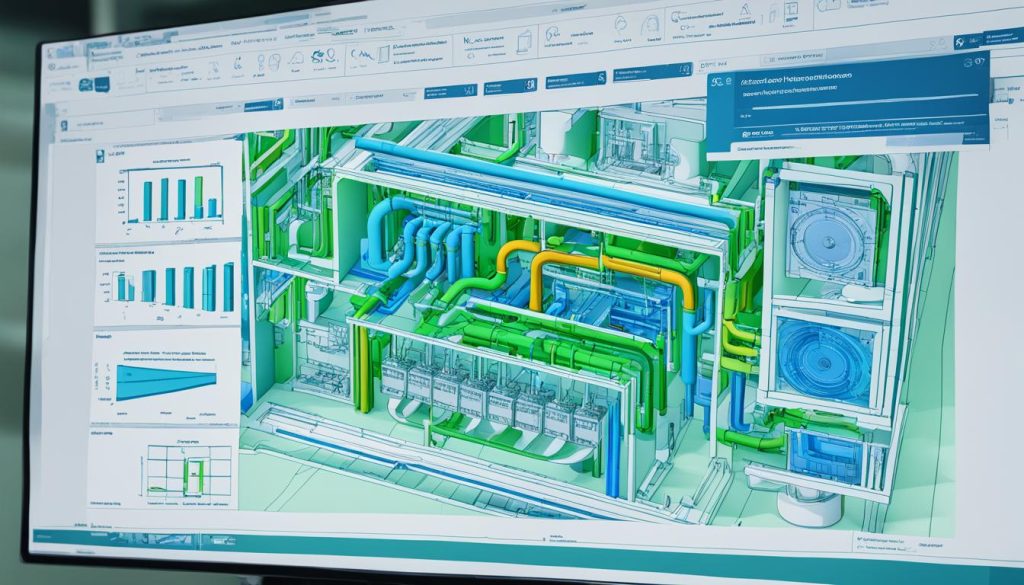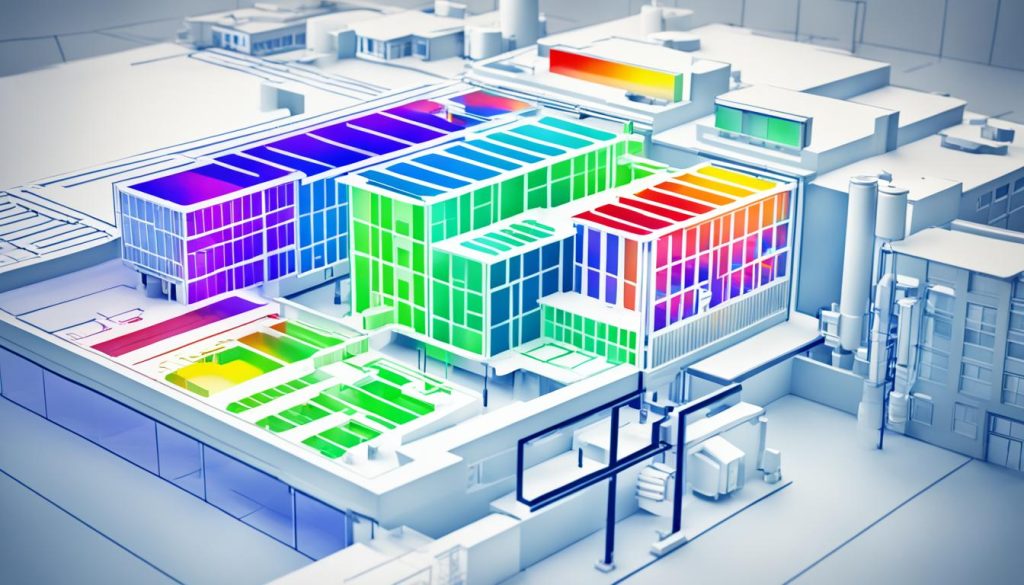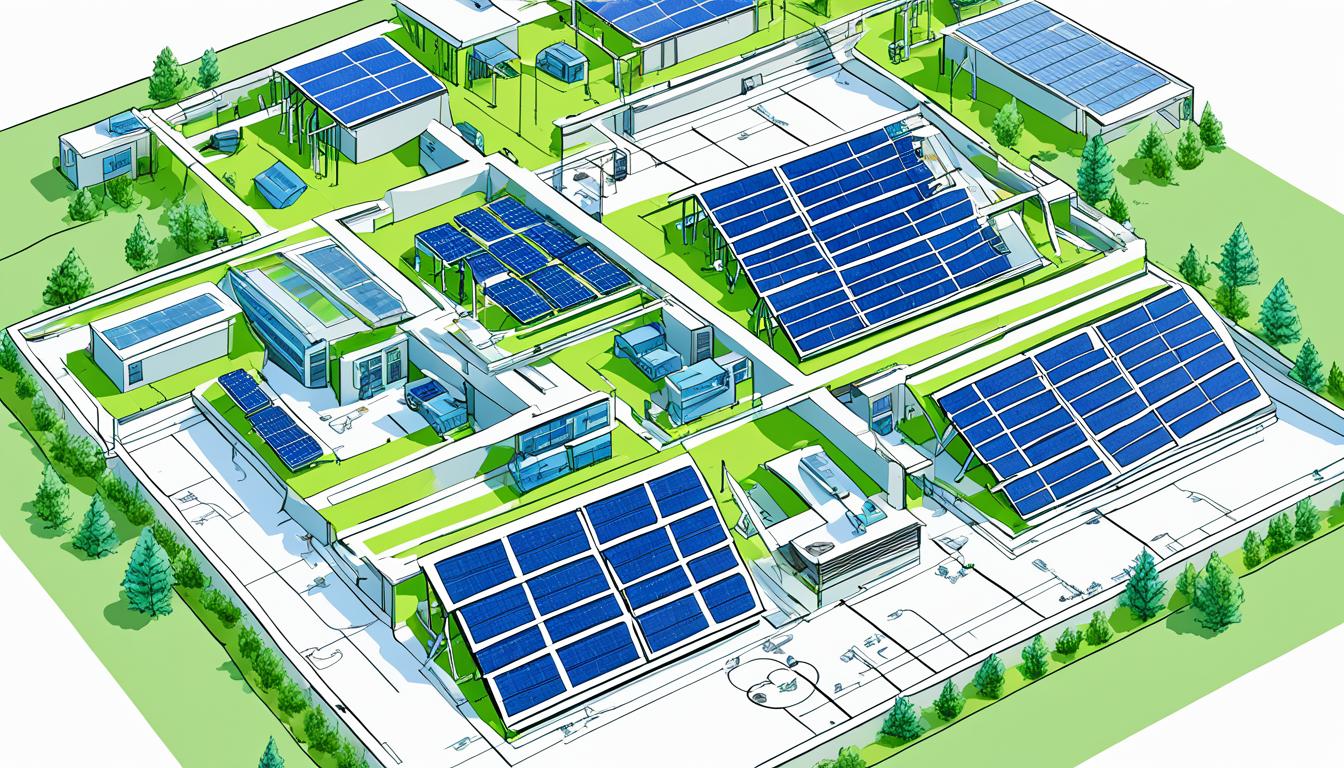AutoCAD HVAC software can greatly improve building energy efficiency. It has powerful tools for design and simulation. You can make precise HVAC system models, do energy analyses, and optimize designs for sustainability.
AutoCAD HVAC design changes how you plan and use energy-efficient HVAC systems. It lets you simulate different scenarios and fine-tune your designs for the best performance. You can make detailed 2D and 3D models, do accurate load calculations, and work well with your team.
With AutoCAD HVAC software, you can find new ways to make HVAC systems sustainable. It has a big library of HVAC symbols and templates to make your work easier. The simulation tools help you see how systems work under different conditions. This way, you can make HVAC designs that are not just efficient but also save money and are better for the environment.
Understanding the Impact of HVAC Systems on Building Energy Consumption
HVAC systems keep buildings comfortable but use a lot of energy. To make buildings use less energy, we need to understand how HVAC systems work. Let’s look at how HVAC affects energy use and how to make them work better.
The Role of HVAC in Total Energy Use
HVAC systems use 40-60% of a building’s energy. This shows why it’s important to analyze HVAC energy use. By knowing how your system uses energy, you can find ways to use less.
Importance of Optimizing HVAC Design for Sustainability
Optimizing your HVAC design is crucial for a sustainable building. A well-thought-out HVAC system is the start of energy-efficient design. This approach cuts energy costs, reduces harm to the environment, and makes indoor spaces healthier for people.
Key Factors Affecting HVAC Energy Efficiency
Several things affect how efficient HVAC systems are:
- System configuration
- Building insulation
- Occupancy patterns
- Climate conditions
- Integration with building architecture
Knowing these factors is key to optimizing HVAC systems. By thinking about each one, you can design your HVAC to fit your building’s needs and use energy wisely.
Introduction to AutoCAD HVAC Software
AutoCAD HVAC software changes how you design heating, ventilation, and air conditioning systems. It makes creating detailed 2D and 3D models for HVAC layouts easier. Let’s look at what it can do, its benefits, and key features that make it vital for HVAC pros.
AutoCAD’s Capabilities for HVAC Design
AutoCAD HVAC software has many features for HVAC design. You can easily make ductwork layouts, place equipment, and design piping systems. Its advanced tools let you see complex HVAC systems in 2D and 3D. This helps you spot problems before you start building.
Benefits of CAD Software in HVAC Planning
Using CAD for HVAC systems has many benefits:
- Increased accuracy in design measurements and calculations
- Improved collaboration among team members
- Faster design iterations and revisions
- Enhanced visualization for clients and stakeholders
- Reduced errors and material waste during installation
Key Features of AutoCAD HVAC Tools
AutoCAD HVAC software has features to make your work better:
| Feature | Description | Benefit |
|---|---|---|
| Symbol Library | Extensive collection of HVAC components | Speeds up design process |
| Duct Sizing | Automatic calculations based on airflow | Ensures efficient system design |
| Load Analysis | Built-in tools for heat load calculations | Optimizes energy efficiency |
| 3D Modeling | Create detailed 3D HVAC models | Improves spatial understanding |
| Clash Detection | Identifies conflicts between systems | Reduces on-site issues |
These tools help you make HVAC systems that are efficient, accurate, and cost-effective. By using AutoCAD, you can make your work easier and deliver better results in your HVAC projects.
Getting Started with AutoCAD HVAC Design
Starting with AutoCAD HVAC design might seem tough, but it’s key for making energy-saving HVAC systems. Learning this tool helps you optimize HVAC systems for better performance and sustainability.
First, get to know AutoCAD’s interface. It has many tools for HVAC planning. Check out the ribbon menu for HVAC commands and functions.
Begin a new project by setting your design goals and specs. Think about the building size, how many people will use it, and the local weather. These details are important for a good HVAC system design.
Make sure to follow the rules and codes for HVAC design in your area. This keeps your designs safe and up to local building standards.
Essential AutoCAD HVAC Design Tools
Use AutoCAD’s strong features to make HVAC design easier:
- Templates: Use pre-made templates to save time and keep projects consistent.
- Commands: Learn shortcuts for common commands to work faster.
- Snaps and Grips: Use these tools for precise HVAC component placement.
- Layers: Keep your drawings tidy with layers for complex designs.
As you get better, focus on making your HVAC systems more efficient. AutoCAD lets you create detailed 3D models. This helps you see and improve your designs for better energy use.
| AutoCAD HVAC Design Feature | Benefit |
|---|---|
| 3D Modeling | Improved visualization and clash detection |
| Parametric Design | Quick changes to system parts |
| Duct Sizing Tools | Right calculations for airflow |
| Energy Analysis | Finds ways to save energy |
Mastering these tools and methods will help you make efficient, green HVAC designs with AutoCAD.
Enhance Design Precision with AutoCAD HVAC Tools
AutoCAD HVAC tools change how you design HVAC systems. They let you make detailed designs with great accuracy. Let’s see how these tools can improve your CAD drafting for HVAC systems.
Creating Detailed 2D and 3D HVAC Models
AutoCAD HVAC tools have everything you need for 2D and 3D models. You can easily switch views to check your HVAC system from all angles. This helps you find problems and make the system better.

Utilizing AutoCAD’s Library of HVAC Symbols and Templates
There’s a huge library of HVAC symbols and templates to use. These save time and keep your designs consistent. You’ll find everything from ductwork to air handlers for complete HVAC system modeling.
Implementing Layers for Organized HVAC System Design
Layers are key for keeping complex HVAC designs tidy. AutoCAD lets you put different parts on separate layers. This makes editing easier, improves teamwork, and helps manage your project better in CAD drafting for HVAC systems.
- Mechanical components layer
- Electrical systems layer
- Plumbing elements layer
- Architectural features layer
Using these AutoCAD HVAC tools, you’ll make HVAC designs that are precise, efficient, and easy to manage. This not only makes your work better but also helps buildings work better and use less energy.
Improve Building Energy Efficiency with AutoCAD HVAC Software
AutoCAD HVAC software changes the game for building energy efficiency. It lets you make precise layouts that use energy well. With its advanced tools, you can do deep HVAC energy studies. This helps you find ways to make your designs better.
This software is great at simulating different situations. You can test out various design choices and see how they affect energy use. You can change things like how many people will be there, the weather, and what equipment you use. This helps you find the best way to save energy in your building.
It also helps cut down on mistakes during construction. By making accurate 3D models, you can catch problems before they cost a lot to fix. This saves money and makes sure your HVAC systems work well when they’re put in.
| Feature | Impact on Building Energy Efficiency |
|---|---|
| Precise system layouts | Optimizes ductwork and equipment placement for reduced energy loss |
| Energy consumption analysis | Identifies high-energy-use areas for targeted improvements |
| Scenario simulation | Tests multiple design options to find the most efficient solution |
| 3D modeling | Reduces construction errors for better real-world performance |
Using these features, you can make HVAC designs that really boost building energy efficiency. The software’s detailed energy studies help you make smart choices. This ensures your HVAC systems use energy efficiently.
Leveraging Simulation Capabilities for Energy Optimization
AutoCAD HVAC software has powerful tools for building energy modeling. These tools help you make HVAC systems work better before they’re built.
Simulating Various Occupancy Levels and Climate Conditions
With HVAC energy simulation, you can see how your system does under different situations. You can check how it handles changing people numbers during the day or week. Also, you can predict how it will work in different seasons and extreme weather.

Analyzing System Performance Under Different Scenarios
Building energy modeling tools in AutoCAD let you test things virtually. You can change things like insulation, window spots, or equipment types. Then, the software shows how much energy it uses and how comfortable it is in each setup.
Fine-tuning HVAC Designs for Optimal Energy Efficiency
After getting detailed data from simulations, you can improve your HVAC system design. This back-and-forth process helps you find the right balance between comfort and saving energy. You might find that bigger ducts or a new zoning plan cuts energy use a lot.
| Simulation Feature | Benefits |
|---|---|
| Occupancy Modeling | Right-size systems, avoid over/under-capacity |
| Climate Analysis | Ensure performance in all weather conditions |
| Equipment Comparison | Select most efficient components |
| Zoning Strategies | Optimize comfort and energy use by area |
Using these advanced simulation tools, you can make HVAC systems that are both comfy and efficient. Testing and improving designs virtually means they work better in real life. This leads to more energy savings.
Streamlining Collaboration in HVAC Design Projects
AutoCAD HVAC design tools change the way teams work on building projects. They bring architects, engineers, and HVAC experts together in one place. This makes decisions faster and designs more in sync.
CAD drafting for HVAC systems makes sharing drawings easy. You can send files to contractors and clients quickly. This keeps everyone informed, which is crucial for sustainable HVAC designs that achieve project goals.
- Real-time updates across team members
- Reduced errors and conflicts in design
- Faster project completion times
- Improved communication between disciplines
AutoCAD works well with many file formats. You can easily import and export drawings. This makes it easy to work with different software tools. Your HVAC designs will fit well with other building systems.
| Collaboration Feature | Impact on HVAC Design |
|---|---|
| Cloud-based sharing | Instant access to latest design changes |
| Version control | Track design evolution and revisions |
| Commenting tools | Efficient feedback and issue resolution |
| 3D visualization | Better spatial understanding for all stakeholders |
Using these collaborative features in AutoCAD HVAC software leads to better HVAC designs. The outcome? Buildings that work well, save energy, and cut costs over time.
Utilizing AutoCAD for HVAC Load Calculations and Energy Analysis
AutoCAD HVAC software is a key tool for making buildings use energy wisely. It has advanced features for doing HVAC load calculations and energy studies.
Performing accurate load calculations
AutoCAD helps you figure out the heating and cooling needs for each building space. It looks at insulation, how many people will use the space, and the local weather. This means your HVAC systems will be the right size, saving energy by not using too much.
Conducting energy consumption analyses
AutoCAD can pull out detailed reports on how much energy your building uses. You can make lists of materials and schedules to see how different HVAC parts use energy. This gives you a full view of how your design is doing.
Identifying opportunities for energy savings
AutoCAD’s simulation tools help you find ways to use less energy. You can compare different HVAC setups and their energy use. This helps you make smart choices to make your HVAC design use less energy.
Source Links
- https://www.linkedin.com/advice/0/how-can-you-use-autocad-design-hvac-systems-c7i6e
- https://outsourceautocaddrafting.com/blogs/cad-drafting-for-hvac-systems-optimizing-energy-efficiency-in-buildings/
- https://forums.autodesk.com/t5/revit-mep-forum/revit-2022-hvac-load-and-energy-simulation-results-validation/td-p/10758541





0 Comments